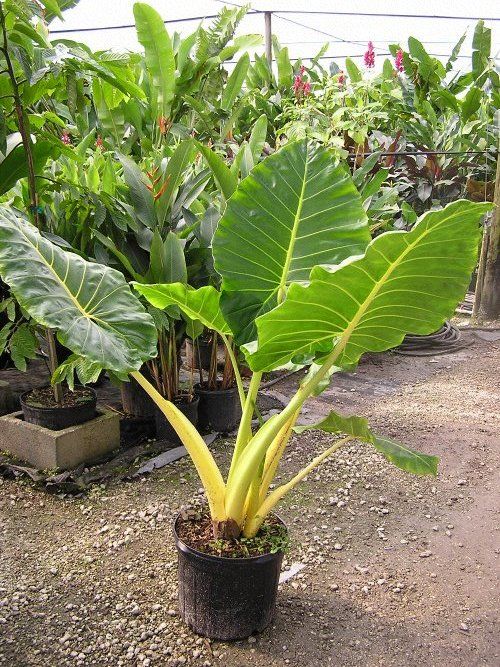Alocasia Lutea Gold
If you’re looking to add a striking, exotic plant to your collection, the Alocasia Lutea Gold (also known as the Gold Elephant Ear) is a fantastic choice. Known for its large, glossy, golden-yellow leaves and dramatic foliage, this plant brings a touch of tropical elegance to any room. In this post, we’ll explore the beauty of the Alocasia Lutea Gold, its unique characteristics, and how to care for it to ensure it thrives indoors.
What is Alocasia Lutea Gold?
Alocasia Lutea Gold, commonly known as the Golden Alocasia, is a member of the Araceae family. Native to Southeast Asia, this plant thrives in warm, humid climates. Its distinguishing feature is its vibrant yellow stems, which contrast beautifully with its large, glossy, heart-shaped leaves. Often referred to as “Elephant Ear” due to the shape of its foliage, the Alocasia Lutea Gold adds a dramatic and tropical vibe to any environment.
Key Features of Alocasia Lutea Gold
- Golden Stems: The bright yellow stems are its signature feature, creating a radiant effect in sunlight.
- Large Leaves: The plant’s oversized green leaves are perfect for adding texture and volume.
- Tropical Vibe: Its bold appearance instantly elevates gardens, patios, and indoor spaces.
- Air Purification: Like many Alocasia varieties, this plant can improve indoor air quality by filtering toxins.
How to Care for Your Alocasia Lutea Gold
While the Alocasia Lutea Gold is an eye-catching plant, it does require a bit of attention to detail in its care to keep it looking its best. However, with the right environment, it will reward you with beautiful, tropical foliage. Here’s what you need to know:
1. Light Requirements
The Alocasia Lutea Gold thrives in bright, indirect light. While it can tolerate some direct sunlight, too much can scorch its delicate leaves, especially in the hotter hours of the day. If you notice the leaves turning pale or brown, it may be a sign that the plant is getting too much direct sunlight. A spot near a north or east-facing window is ideal for this plant.
In low light conditions, the plant’s growth may slow, and the vibrant yellow color may fade, so it’s best to provide as much natural light as possible. If natural light is limited, you can supplement with grow lights.
2. Watering
Like most Alocasia plants, the Lutea Gold prefers its soil to remain consistently moist but not soggy. Water when the top 1 to 2 inches of soil feel dry to the touch, but always ensure that the pot has good drainage to prevent root rot. Avoid letting the plant sit in water, as standing water can lead to root issues.
During the winter months, when the plant’s growth slows down, you may need to reduce the frequency of watering. Always check the moisture level before watering to avoid overwatering.
3. Humidity
The Alocasia Lutea Gold is a tropical plant that thrives in high humidity. Ideally, humidity levels should be between 60% and 80% for the best growth. If you live in a dry climate or if your home has dry air (especially during the winter), consider using a humidifier, misting the plant, or placing it on a humidity tray.
Grouping the plant with other humidity-loving plants can also create a microenvironment that helps maintain moisture around it.
4. Temperature
This tropical beauty prefers temperatures between 65°F and 80°F (18°C to 27°C). It is sensitive to cold temperatures and should not be exposed to drafts or temperatures below 50°F (10°C), as it can cause stress and damage the plant. Keep it in a warm, consistent environment, away from cold windows, air conditioners, or heating vents.
5. Soil
The Alocasia Lutea Gold requires a well-draining, aerated potting mix. A peat-based potting soil with added perlite or orchid bark is a good option for ensuring proper drainage. Make sure the pot has drainage holes to allow excess water to escape, preventing water from accumulating at the base, which can lead to root rot.
6. Fertilizing
During the growing season (spring and summer), feed your Alocasia Lutea Gold every 4 to 6 weeks with a balanced, water-soluble fertilizer. You can use a general houseplant fertilizer or one designed for tropical plants. In the fall and winter, reduce fertilizing, as the plant’s growth slows down during this time.
7. Repotting
The Alocasia Lutea Gold grows relatively quickly, and you may need to repot it every 1 to 2 years to provide enough space for its roots. Choose a pot that is only 1 to 2 inches larger than the current one to prevent root rot caused by excess moisture retention in a too-large pot.
Why You Should Add an Alocasia Lutea Gold to Your Collection
The Alocasia Lutea Gold is a showstopper with its vibrant, golden-yellow leaves and striking, tropical look. Its relatively compact growth habit makes it perfect for a range of indoor spaces, from small apartments to larger living rooms. Whether used as a statement piece in a corner of your home or placed on a shelf or table, this plant’s bold, glossy leaves are sure to catch the eye and become a focal point of any room.
Despite its tropical roots, it’s a fairly low-maintenance plant as long as its humidity, light, and watering needs are met. Plus, it adds a unique touch to your indoor garden with its exotic look.

